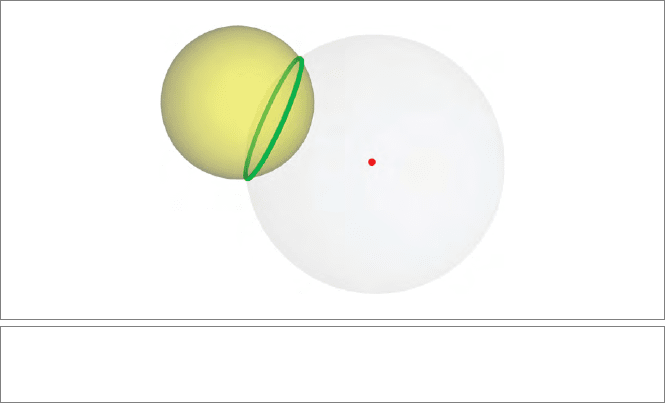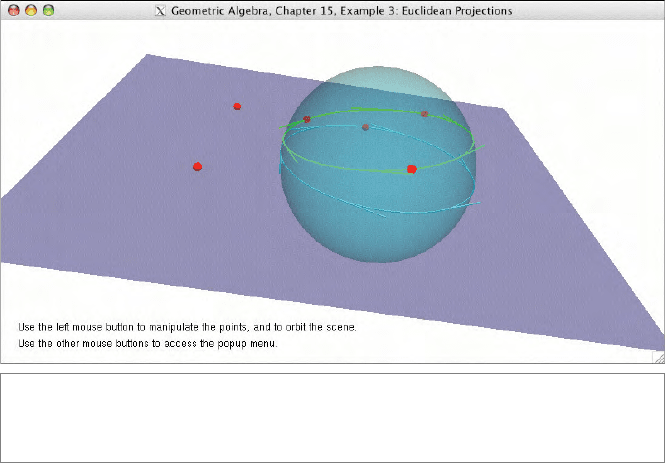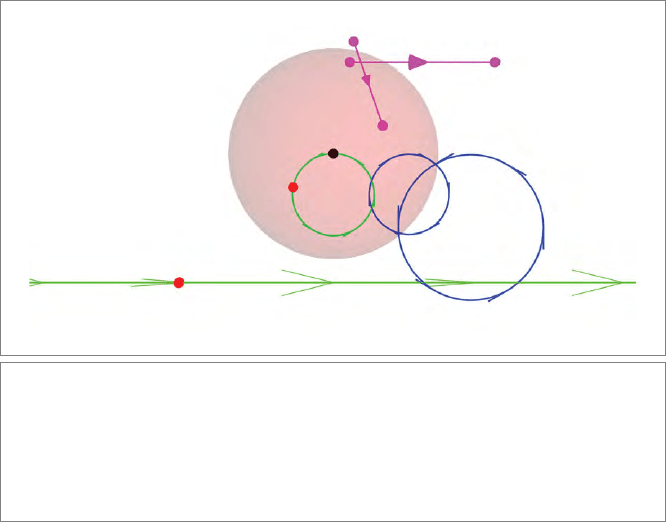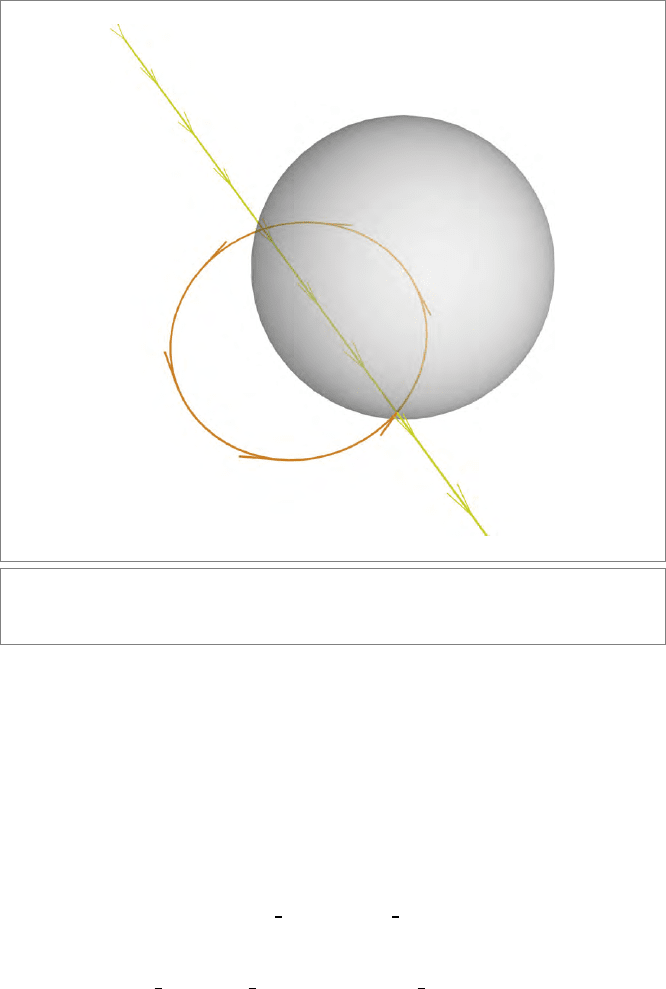Dorst L., Fontijne D., Mann S. Geometric Algebra for Computer Science. An Object Oriented Approach to Geometry
Подождите немного. Документ загружается.


462 CONSTRUCTIONS IN EUCLIDEAN GEOMETRY CHAPTER 15
K
p
∑
Figure 15.13: Construction of the contour circle K of a dual sphere σ = Σ
∗
seen from a
point p (see Exercise 9).
15.8 PROGRAMMING EXAMPLES AND EXERCISES
The three examples for this chapter are interactive versions of Figure 15.2 (the plunge),
Figure 15.8 (affine combinations of points), and Figure 15.10 (Euclidean projections),
respectively.
15.8.1 THE PLUNGE
This example draws a green circle that is the plunge of the following three primitives:
const int NB_PRIMITIVES = 3;
mv g_primitives[NB_PRIMITIVES] = {
// point:
c3gaPoint( — 1.0f, 1.5f, 0.0f),
// dual sphere:
3.25f * e1 + 2.68f * e2 — 0.34f * e3 + 1.00f * no + 8.43f * ni,
// dual plane:
— e2 + 2.0f * ni,
};
Computing and drawing the plunge is as simple as
draw(g_primitives[0] ^ g_primitives[1] ^ g_primitives[2]);
You can translate the sphere and the point. Notice how the circle always intersects the
point, sphere, and plane orthogonally.

SECTION 15.8 PROGRAMMING EXAMPLES AND EXERCISES 463
15.8.2 AFFINE COMBINATIONS OF POINTS
As described in Section 15.2.4, affine combinations of points are circles in E
2
. This
example uses
c2ga to implement an interactive version as shown in Figure 15.14. The
code to draw the circles is:
const mv::Float STEP = 0.1f;
for (mv::Float lambda = — 1.0f; lambda <= 2.0f; lambda += STEP) {
// set color, turn GL stipple on when circle is imaginary.
// ... (omitted)
// draw the circle:
draw(lambda * g_points[0] + (1.0f — lambda) * g_points[1]);
}
As an extra feature, the example also draws the bisecting line (in green) between the two
points, using:
draw(g_points[0] - g_points[1]);
Figure 15.14: Screenshot of Example 2.

464 CONSTRUCTIONS IN EUCLIDEAN GEOMETRY CHAPTER 15
Figure 15.15: Screenshot of Example 3. The green circle is projected onto the blue plane.
The projection is drawn in cyan. The sphere is the
plunge of circle and plane, which explains
the geometry of the projection.
15.8.3 EUCLIDEAN PROJECTIONS
As described in Section 15.3, orthogonal projection in the conformal model behaves
somewhat unexpectedly. This example draws a line or circle, and its projection onto a
plane. You can change the arguments interactively, and optionally cause the
plunge to be
drawn. Figure 15.15 shows a screenshot.
From formula to program is straightforward, for the projection itself is drawn using
// CL is circle or line
// PL is plane
draw((CL << inverse(PL)) << PL);
and the optional plunge is drawn as:
draw(CL ^ dual(PL));
16
CONFORMAL OPERATORS
Even with all the new techniques for Euclidean geometry in the previous three chapters,
the possibilities of the conformal model are not exhausted. There are more versors in it,
and they represent other useful transformations. Euclidean motions were just a special
case of doing conformal transformations, which preserve angles. These also include reflec-
tion in a sphere and uniform scaling.
All conformal transformations are generated by versor products using the elementary
vectors of the conformal model. Whereas the Euclidean motions of the previous chapter
involved using the vectors representing dual planes, we now use the dual spheres. An
important operation we can then put into rotor form is uniform scaling, and that per-
mits a closed-form solution to the interpolation of rigid body motions with scaling.
The fact that the general conformal transformations can be represented as versors finally
explains the name of the conformal model.
16.1 SPHERICAL INVERSION
The most elementary conformal transformation is the reflection in a unit sphere, called
(spherical) inversion. As a versor, the spherical inversion in the unit sphere Σ around the
465

466 CONFORMAL OPERATORS CHAPTER 16
origin involves the vector σ = o −∞/2, representing this sphere dually. The spherical
reflection is performed by the versor product:
X → σ
X σ
−1
.
A unit sphere of weight 1 (so that −∞· σ = 1) is equal to its own inverse, simplifying the
equation slightly. We compute the effect on the basic elements:
o →−(o −
1
2
∞) o (o −
1
2
∞) = −
1
4
∞o ∞ = ∞/2
∞ →−(o −
1
2
∞) ∞(o −
1
2
∞) = −o ∞o = 2o
E → (o −
1
2
∞)
E (o −
1
2
∞) = −
1
2
o
E ∞ +
1
2
∞
E o = −E(o ·∞) = E.
It is clear that this is not a Euclidean transformation, for ∞ is not preserved but
interchanged with o (and weighted). Geometrically, this is understandable: the point at
infinity reflects to the center of the sphere, and vice versa. The total result on a point
x =
T
x
[o] is
T
x
[o] = o + x +
1
2
x
2
∞ → x
2
o + x
−1
+
1
2
x
−2
∞
= x
2
T
x
−1
[o].
Not only does the point x endupatlocationx
−1
(which is the inverse of x, hence the name
inversion), but its weight also changes by a factor x
2
. A real dual unit sphere gives a point
in the same direction as x; an imaginary dual unit sphere gives
T
x
[o] →−x
2
T
−x
−1
[o] (as
you can derive in structural exercise 1). Therefore the latter performs an inversion, while
simultaneously reflecting in the origin, which is somewhat surprising but pleasant to have
available as a versor.
Figure 16.1 shows the inversion of various elements in a sphere. Containment relation-
ships are of course preserved, but there is more. The spherical inversion is a conformal
transformation: it preserves local angles. In the figure, the angle between the green line
and blue circle is the same as between their images after reflection. This angle preserva-
tion property is best demonstrated by considering two tangents at the same location p,
which are p ∧
p(u ∞)
and p ∧
p(v ∞)
. Inverting the tangent p ∧
p(u ∞)
using
the equations above, we find it in a nonstandard form as
2p
4
p
∧
p
(u o)
,
where we used the notation p
for the unit point at location p
−1
. Using the direction
formula from Table 14.1 and some algebraic simplification, you can establish that the
direction of this tangent equals −pup∞. Therefore the inversion of the tangent can be
written in standard form as
p
∧
p
(−pup∞)
.
The other tangent transforms in a similar way. If we now study the ratio of their
Euclidean direction vectors at their common location, that transforms from v/u to

SECTION 16.2 SPHERICAL INVERSION 467
p
K
Λ
σ p σ
−1
∧
σΛσ
−1
∧
σ Γ σ
−1
∧
Γ
∧
σKσ
−1
Figure 16.1: Inversion of various elements in a unit sphere (shaded in red) produces their
reflection relative to that sphere. We show a point p at location p relative to the sphere’s origin
(denoted in black) that becomes a point at location 1/p; an oriented line Λ that becomes a circle
through the center; a circle K that becomes a circle; and a point pair Γ that becomes a point
pair. The black point at the center is the reflection of the point at infinity. Labels of the rounds
are indicated at their centers. All containment and composition relationships are preserved, as
are angles between the elements before and after reflection.
(−pvp)/(−pup) = p (v/u) p
−1
. This is a simple reflection in the plane with normal
p. For the two vectors u and v, it affects the attitude of their plane u ∧ v, but not the
magnitude of their relative sine or cosine. So although being in a different plane, the
angle between u and v is preserved. It follows that reflection in a plane is a conformal
transformation, and so is reflection in a sphere.
In contrast to the Euclidean operators we treated so far, the inversion in the sphere does
not preserve the class of the element it acts on: the consequence of essentially swapping o
and ∞ is that flats can become rounds and directions can become tangents at the origin.
This is also clear from the characterization of the classes in Table 14.1, which worked by
testing whether ∞X and/or ∞∧X are zero: the nonpreservation of ∞ implies that such
a condition holding for X may not hold for the transformed X.
Spherical inversions have interesting applications, and a well-chosen inversion can often
transform a geometrical problem into a much simpler problem. Many examples of
this may be found in [46], though in a classical form using complex numbers in the
plane.The conformal model allows a much more powerful treatment of this principle
in n-dimensional base spaces.

468 CONFORMAL OPERATORS CHAPTER 16
16.2 APPLICATIONS OF INVERSION
16.2.1 THE CENTER OF A ROUND
We have seen above how the point at infinity ∞ was reflected into (twice) the center o
of the unit sphere at the origin that we were considering. Due to the versor nature, this
result is translation-covariant, so that the center of an arbitrar y sphere can be obtained by
reflection of ∞ in it. There are some constants involved to obtain the center in normalized
form, and the resulting formula is
center of sphere: c = −
1
2
ρ
2
σ ∞σ
−1
= −
1
2
σ ∞σ
(∞·σ)
2
,
resulting in a normalized point. A general round can be factored into a sphere cut by
planes through its center. T hose subsequent reflections do not disturb the location of the
center, so the general formula is as indicated in Table 14.1.
16.2.2 REFLECTION IN SPHERES AND CIRCLES
The straightforward application of spherical inversion is to compute the reflection in a
sphere of arbitrary elements. We have used this above in Figure 16.1 for the reflection
in a unit sphere around the origin. By now you should be confident that this may be
extended to arbitrar y spheres anywhere, because it is a versor product, and will therefore
combine well with other versor products. We can move the unit sphere or the elements
anywhere, in any orientation, and still σ
X /σ will perform the reflection, as illustrated in
Figure 16.2. The only thing we cannot show now is that we are also allowed to change
the radius of the sphere in a structure-preserving manner, although this may be obvious
geometrically. We leave that until after we have the rotor for that scaling (already in the next
section), and that will permit the rotor representation of reflection in spheres of arbitrary
radius.
We can also compose the reflections, first reflecting in a plane π and then in a sphere σ
cutting the plane orthogonally (so that π ·σ = 0). The total result is that we have used the
versor πσ:
reflection in a circle: X → (πσ)
X (πσ)
−1
.
Since π was chosen through the center of the sphere σ, the versor πσ is the dual repre-
sentation of the circle that is their meet (as in the factorization of Section 15.2.3). This
versor construction therefore gives a sensible meaning to reflection in a circle. In its plane,
this acts like spherical inversion, but it can also be extended to act outside that plane.
We found it hard to draw a convincing picture of this; because of its essential 3-D nature,
it is best studied live in an interactive visualization. Structural exercise 3 explores reflection

SECTION 16.3 SCALING 469
∧
σΛ/σ
σ
Λ
Figure 16.2: An oriented Euclidean line Λ is reflected in a sphere σ by the versor product
σ
Λ
σ
−1
to become a circle through the center.
in a point pair, which is interestingly different from spherical reflection, even in the
plane.
16.3 SCALING
16.3.1 THE POSITIVE SCALING ROTOR
In Section 13.2.2, we generated a translation from reflections in two parallel dual planes.
The natural question now is: What can we generate from the reflections in two “parallel”
spheres (i.e., concentric spheres o −
1
2
ρ
2
1
∞ and o −
1
2
ρ
2
2
∞)?
We obtain a composite versor that is the product of the two inversions, and simplify:
(o −
1
2
ρ
2
2
∞)(o −
1
2
ρ
2
1
∞) = (ρ
2
1
+ ρ
2
2
) −
1
2
(ρ
2
1
− ρ
2
2
) o ∧∞.

470 CONFORMAL OPERATORS CHAPTER 16
One would expect only the ratio of the sizes of the spheres to matter. We rescale the versor
through dividing by 2ρ
1
ρ
2
, and conveniently define a characteristic parameter γ through
exp(γ/2) = ρ
2
/ρ
1
.
Now some algebraic manipulation gives a pleasant standard form,
S
γ
= cosh(γ/2) + sinh(γ/2) o ∧∞= e
γ o∧∞/2
,
where the rewriting of the resulting rotor as an exponential uses the results in Section 7.4
combined with (o ∧∞)
2
= 1.
You may guess what the effect of this rotor is, since you know that it is geometrically a dou-
ble sphere inversion: it scales elements relative to the origin. We compute what happens to
the basic components of our representation. For brevity define O ≡ o ∧∞(it represents
the unit flat point at the origin), and note that O
2
= 1,aswellasOo = −o = −oOand
O ∞ = ∞ = −∞O. With that, it is easy to derive that
S
γ
[∞] =
cosh(γ/2) + sinh(γ/2) O
∞
cosh(γ/2) − sinh(γ/2) O
=
cosh(γ/2) + sinh(γ/2) O
2
∞ = e
γ
∞.
Using the commutation relationships, you should dare to abbreviate this derivation as
S
γ
[∞] = e
γO/2
∞e
−γO/2
= e
γO
∞ =
cosh(γ) + sinh(γ) O
∞ = e
γ
∞.
(16.1)
(Verify all steps in detail, if you need to be convinced.) Similarly,
S
γ
[o] = e
γO/2
oe
−γO/2
= e
γO
o =
cosh(γ) − sinh(γ) O
o = e
−γ
o.
(16.2)
The bivector O commutes with a purely Euclidean blade x,so
S
γ
[E] = E.
In total, we find for the transform of a general point x =
T
x
[o]
S
γ
[x] = e
−γ
o + (e
γ
x) +
1
2
(e
γ
x)
2
∞
= e
−γ
T
e
γ
x
[o]. (16.3)
This clearly shows that the spatial aspects are scaled by e
γ
(as well as weighted by e
−γ
).
So this is indeed a spatial scaling. You should realize that it has been characterized by an
exponential parameter; so to obtain a scaling by a factor of 2, you need to use γ = log(2).
Note that this transformation is almost a Euclidean transformation: it does not quite pre-
serve the point at infinity (as a Euclidean transfor mation would), but it merely weights it
(which is not too bad). In particular, the ty pe of an element is preserved in scaling, since
the conditions of Table 14.1 are not affected by a weight on ∞. So rounds remain rounds,
SECTION 16.3 SCALING 471
and flats remain flats. No Euclidean transformation can affect the size of an object, but
once it has been determined by a scaling, it is nicely preserved.
There is a slight paradox in this use of the scaling rotor. The distance between Euclidean
point representatives was originally defined through a ratio of inner products by (13.2). If
the distance between the points should increase, so should the value of that inner product
ratio. But the inner product is an invariant of the orthogonal transformation produced
by the scaling rotor (by definition of an orthogonal transformation). When you check,
you find that this indeed holds, because the scaling changes ∞ to e
γ
∞ and (16.3) trades
spatial scale for point weight.
However, if we use the distance definition relative to the original point at infinity ∞,we
find that the Euclidean distance of the points has indeed increased by a factor of e
γ
after
scaling by S
γ
. Apparently, that is how we should use the definition of distance: always
relative to the original point at infinity.
This inter pretation afterwards of course does not affect the consistency of the conformal
model computations. Having scaling available as a rotor means that all our constructions
are automatically structurally preserved under a change of scale—we never need to check
that they are. For instance, any construction made with a unit sphere using the products
of our geometry can be simply rescaled to involve any sphere of any radius at any position
without affecting its structure. This scaling does not even need to be done relative to the
origin; by virtue of the structure preservation, a scaling around another location t is simply
made by applying the translation rotor to the scaling rotor to obtain the translated scaling
as
T
t
[S
γ
].
16.3.2 REFLECTION IN THE ORIGIN: NEGATIVE SCALING
When one of the parallel two reflecting spheres is imaginary, their product is a versor that
is capable of reflecting in the origin. The prototypical example of this is the product of
two unit spheres, one real, one imaginary. This gives the element
(o −∞/2) (o + ∞/2) = o ∧∞.
This is the flat point in the origin, which makes perfect sense: negative scaling is like reflec-
tion in the origin. Its action on a conformal point is
T
x
[o] →−T
−x
[o].
Even though this is an even versor, it is not a rotor, for (o ∧∞)(o ∧∞)= −1. Therefore
it cannot be performed in small amounts, and it cannot be expressed as the exponential
of a bivector. It is a transformation, but not a motion.
You can combine this reflection in the origin with a scaling versor to effectively make a
versor that can perform a negative scaling.
